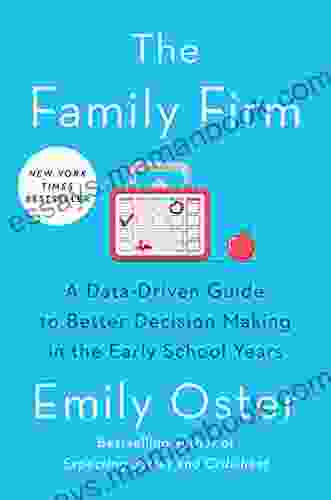A Data-Driven Guide to Better Decision-Making in the Early School Years

In the early school years, data can be a powerful tool for making better decisions about instruction and intervention. When used effectively, data can help teachers to:
4.4 out of 5
| Language | : | English |
| File size | : | 7872 KB |
| Text-to-Speech | : | Enabled |
| Screen Reader | : | Supported |
| Enhanced typesetting | : | Enabled |
| X-Ray | : | Enabled |
| Word Wise | : | Enabled |
| Print length | : | 318 pages |
- Identify students who are struggling and need additional support
- Monitor student progress and make adjustments to instruction as needed
- Evaluate the effectiveness of different teaching strategies
- Communicate with parents and other stakeholders about student progress
However, collecting, analyzing, and interpreting data can be a challenge. This article provides a comprehensive overview of how to use data to make better decisions in the early school years. We will cover the following topics:
- Collecting data
- Analyzing data
- Interpreting data
- Using data to inform instruction and intervention
Collecting Data
The first step in data-driven decision-making is to collect data. There are many different types of data that can be collected, including:
- Student assessment data: This data includes information about student performance on tests, quizzes, and other assessments.
- Student work samples: This data includes examples of student work, such as essays, projects, and portfolios.
- Observation data: This data includes information about student behavior and engagement in the classroom.
- Attendance data: This data includes information about student attendance and absences.
- Demographic data: This data includes information about student demographics, such as age, gender, race, and socioeconomic status.
The type of data that you collect will depend on the specific decisions that you are trying to make. For example, if you are trying to identify students who are struggling in reading, you would collect data on student assessment data in reading. If you are trying to evaluate the effectiveness of a new teaching strategy, you would collect data on student work samples and observation data.
There are a variety of ways to collect data. Some common methods include:
- Paper and pencil assessments: These are traditional assessments that are administered on paper and pencil.
- Computer-based assessments: These assessments are administered on a computer or tablet.
- Performance assessments: These assessments require students to demonstrate their skills and knowledge through performance tasks.
- Observation: This involves observing students in the classroom to collect data on their behavior and engagement.
- Interviews: This involves interviewing students, parents, and other stakeholders to collect data on their perspectives and experiences.
The method of data collection that you choose will depend on the type of data that you are collecting and the resources that you have available.
Analyzing Data
Once you have collected data, the next step is to analyze it. Data analysis involves examining the data to identify patterns and trends. There are a variety of statistical techniques that can be used to analyze data, but the specific techniques that you choose will depend on the type of data that you have collected.
Here are some common data analysis techniques:
- Descriptive statistics: These statistics describe the data in a summary way, such as the mean, median, and mode.
- Inferential statistics: These statistics allow you to make inferences about the population based on the data that you have collected.
- Correlation analysis: This technique examines the relationship between two or more variables.
- Regression analysis: This technique examines the relationship between a dependent variable and one or more independent variables.
- Factor analysis: This technique identifies the underlying factors that explain the variance in the data.
Data analysis can be a complex process, but there are a variety of resources available to help you. Many statistical software packages are available that can help you to analyze data, and there are also many online tutorials and courses that can teach you how to use these software packages.
Interpreting Data
Once you have analyzed the data, the next step is to interpret the results. This involves drawing s from the data and making recommendations for action. When interpreting data, it is important to consider the following factors:
- The quality of the data: The quality of the data will affect the validity and reliability of your s.
- The context of the data: The context of the data will help you to understand the results and make recommendations for action.
- Your own biases: It is important to be aware of your own biases when interpreting data, as this can affect your s.
Interpreting data can be a challenging process, but it is an essential step in data-driven decision-making. By carefully considering the quality of the data, the context of the data, and your own biases, you can draw s from the data that are valid and reliable.
Using Data to Inform Instruction and Intervention
Once you have interpreted the data, the next step is to use the results to inform instruction and intervention. This involves making changes to your teaching based on the data that you have collected. Here are some ways to use data to inform instruction and intervention:
- Identify students who are struggling and need additional support: By analyzing data on student assessment data, work samples, and observation data, you can identify students who are struggling and
4.4 out of 5
| Language | : | English |
| File size | : | 7872 KB |
| Text-to-Speech | : | Enabled |
| Screen Reader | : | Supported |
| Enhanced typesetting | : | Enabled |
| X-Ray | : | Enabled |
| Word Wise | : | Enabled |
| Print length | : | 318 pages |
Do you want to contribute by writing guest posts on this blog?
Please contact us and send us a resume of previous articles that you have written.
 Top Book
Top Book Novel
Novel Fiction
Fiction Nonfiction
Nonfiction Literature
Literature Paperback
Paperback Hardcover
Hardcover E-book
E-book Audiobook
Audiobook Bestseller
Bestseller Classic
Classic Mystery
Mystery Thriller
Thriller Romance
Romance Fantasy
Fantasy Science Fiction
Science Fiction Biography
Biography Memoir
Memoir Autobiography
Autobiography Poetry
Poetry Drama
Drama Historical Fiction
Historical Fiction Self-help
Self-help Young Adult
Young Adult Childrens Books
Childrens Books Graphic Novel
Graphic Novel Anthology
Anthology Series
Series Encyclopedia
Encyclopedia Reference
Reference Guidebook
Guidebook Textbook
Textbook Workbook
Workbook Journal
Journal Diary
Diary Manuscript
Manuscript Folio
Folio Pulp Fiction
Pulp Fiction Short Stories
Short Stories Fairy Tales
Fairy Tales Fables
Fables Mythology
Mythology Philosophy
Philosophy Religion
Religion Spirituality
Spirituality Essays
Essays Critique
Critique Commentary
Commentary Glossary
Glossary Bibliography
Bibliography Index
Index Table of Contents
Table of Contents Preface
Preface Introduction
Introduction Foreword
Foreword Afterword
Afterword Appendices
Appendices Annotations
Annotations Footnotes
Footnotes Epilogue
Epilogue Prologue
Prologue Joel Grus
Joel Grus Joanne N Wright
Joanne N Wright Benedikt Koehler
Benedikt Koehler Sabra Loomis
Sabra Loomis Heather Hathaway
Heather Hathaway Elaine Royal
Elaine Royal Karl Marx
Karl Marx Lynn Schiffhorst
Lynn Schiffhorst Bill Minutaglio
Bill Minutaglio H Rider Haggard
H Rider Haggard Joe
Joe Jen Jones
Jen Jones Jason Schmetzer
Jason Schmetzer Francesca Clare Rayner
Francesca Clare Rayner Morgan Moeller
Morgan Moeller Melissa Foster
Melissa Foster Anna Ziegler
Anna Ziegler Morgan Robertson
Morgan Robertson Jedidiah Jenkins
Jedidiah Jenkins Madison Jones
Madison Jones
Light bulbAdvertise smarter! Our strategic ad space ensures maximum exposure. Reserve your spot today!

 Julio CortázarNew Baby Therapy Elf Help Kelly Thompson: A Comprehensive Guide to Navigating...
Julio CortázarNew Baby Therapy Elf Help Kelly Thompson: A Comprehensive Guide to Navigating...
 Fyodor DostoevskyCarmen Suite for Clarinet Quartet: An In-Depth Exploration of Bizet's...
Fyodor DostoevskyCarmen Suite for Clarinet Quartet: An In-Depth Exploration of Bizet's... Charles BukowskiFollow ·15.9k
Charles BukowskiFollow ·15.9k Jacob FosterFollow ·10.1k
Jacob FosterFollow ·10.1k Douglas AdamsFollow ·13.1k
Douglas AdamsFollow ·13.1k Dylan HayesFollow ·15.5k
Dylan HayesFollow ·15.5k Eddie BellFollow ·11k
Eddie BellFollow ·11k Shaun NelsonFollow ·11.3k
Shaun NelsonFollow ·11.3k Derek CookFollow ·14.5k
Derek CookFollow ·14.5k Diego BlairFollow ·13k
Diego BlairFollow ·13k

 Dean Butler
Dean ButlerBlack Widow 2024: A Comprehensive Guide to Kelly...
In 2024, Marvel...

 Gage Hayes
Gage HayesNothing and the Speck: An In-Depth Analysis of Yana...
Yana Toboso's works, particularly the manga...

 Stan Ward
Stan WardThe Best American Poetry 1997: James Tate
The Best American Poetry...

 Corey Green
Corey GreenThe Chance of Home: Exploring the Poetic Landscape of...
Immerse yourself in the evocative world of...
4.4 out of 5
| Language | : | English |
| File size | : | 7872 KB |
| Text-to-Speech | : | Enabled |
| Screen Reader | : | Supported |
| Enhanced typesetting | : | Enabled |
| X-Ray | : | Enabled |
| Word Wise | : | Enabled |
| Print length | : | 318 pages |












